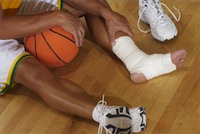 It’s “March Madness” time again… when the talk is full of brackets, Sweet Sixteens and Final Four. It is also the time when some of those college basketball players will see their season ended by an injury. Of the 98 injured players currently sidelined from the 2012 NCAA Championships, the majority have knee and foot injuries. Many ERs and orthopedic practices also see an uptick in these same types of injuries, as teens and weekend warriors, inspired by March Madness, hit the basketball courts without the proper preparation. As a result, about 200,000 children under the age of 15 are treated in the ER annually for injuries related to the sport.
It’s “March Madness” time again… when the talk is full of brackets, Sweet Sixteens and Final Four. It is also the time when some of those college basketball players will see their season ended by an injury. Of the 98 injured players currently sidelined from the 2012 NCAA Championships, the majority have knee and foot injuries. Many ERs and orthopedic practices also see an uptick in these same types of injuries, as teens and weekend warriors, inspired by March Madness, hit the basketball courts without the proper preparation. As a result, about 200,000 children under the age of 15 are treated in the ER annually for injuries related to the sport.
There are two general categories of injuries that basketball players of every level suffer from: overuse and trauma. Common injuries from overuse are patellar, Achilles and shoulder tendinitis, along with ankle and wrist sprains; while traumatic injuries are often meniscal and ACL ligament tears, or fractures to the hands and feet. Prompt and proper medical treatment, including immobilization, physical therapy and rest, results in speedy and successful recovery from most minor injuries. In the case of tears and fractures, however, surgery may be required in conjunction with a lengthy period of recovery and no guaranteed outcome. Therefore it is important that both the casual and professional basketball player add preventative measures to their athletic routine in order to reduce the chance of serious injury.
Some of these measures are as follows :
- Take sufficient time to stretch and warm up. Cold muscles are prone to injury, so resist the temptation to join in the game immediately. A good warm-up is about 5-10 minutes where you may even break a sweat, followed by a series of stretches of about 15-30 reps per stretch or body part.
- Develop a consistent conditioning routine. With about 26 bones and 20 muscles in the feet, strength training of these limbs is essential. Many trainers advocate a daily or weekly barefoot workout of 5-15 minutes to fortify, toes, feet and especially ankles.
- Train in low-top sneakers. High-top basketball shoes add rigidity and support to the ankle which is important given the physicality of the game. However, wearing high-tops for long periods of conditioning could result in too much immobilization, stiffness and even atrophy of the joints and muscles. Save true basketball shoes for the game.
- Make sure your basketball shoes fit properly and they have a non-skid sole. Loss of tread contributes significantly to ankle and knee injuries. Have your feet measured by the store and try shoes on at the end of the day or after a workout when your feet are at their largest. This saves you from ending up with shoes that are too tight. Try on with the same type of socks you wear during a game to ensure proper sizing and allow sufficient time for trying them out in the store.
Physical Therapists would be wise to remind their patients with basketball related injuries that not everyone is a Michael Jordan, Kobe Bryant or LeBron James, and that following the above tips will allow them to enjoy March Madness to its fullest for years to come.
If you are a PT in sports medicine or any other rehab specialty, and are looking to find a proper fit for your talents contact the Centra Team at 800 535 0076.